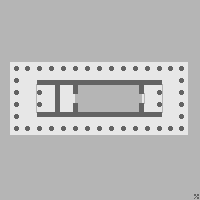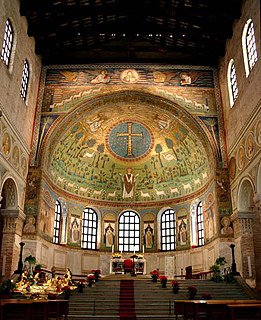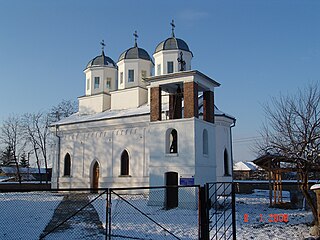Coordinates: 42°42′4″N23°19′44″E / 42.70111°N 23.32889°E

A geographic coordinate system is a coordinate system that enables every location on Earth to be specified by a set of numbers, letters or symbols. The coordinates are often chosen such that one of the numbers represents a vertical position and two or three of the numbers represent a horizontal position; alternatively, a geographic position may be expressed in a combined three-dimensional Cartesian vector. A common choice of coordinates is latitude, longitude and elevation. To specify a location on a plane requires a map projection.

The Church of St Paraskeva (Bulgarian : църква "Света Параскева", tsarkva "Sveta Paraskeva") is a Bulgarian Orthodox church in Sofia, the capital of Bulgaria. The church, dedicated to Saint Paraskeva, is located on 58 Georgi Rakovski Street in the centre of the city. It is the third-largest church in Sofia.

Bulgarian, is an Indo-European language and a member of the Southern branch of the Slavic language family.

The Bulgarian Orthodox Church is an autocephalous Orthodox Church. It is the oldest Slavic Orthodox Church with some 6 million members in the Republic of Bulgaria and between 1.5 and 2.0 million members in a number of European countries, the Americas, Australia, New Zealand and Asia. It was recognized as an independent Church by the Patriarchate of Constantinople in AD 870, becoming Patriarchate in 918/919.

Sofia is the capital and largest city of Bulgaria. The city is at the foot of Vitosha Mountain in the western part of the country. Being in the centre of the Balkan peninsula, it is midway between the Black Sea and the Adriatic Sea, and closest to the Aegean Sea.
Plans to build a church at the site date to 1910, when Stuttgart-educated Bulgarian architect Anton Tornyov (1868–1942) won a competition for the church's design. Due to the Balkan Wars and World War I, however, the construction was postponed. In 1922, the church board of trustees announced another competition, which was again won by Tornyov. The construction of the Church of St Paraskeva was complete by 1930, but the finishing works on the porticos did not cease until 1940. [1]

Stuttgart is the capital and largest city of the German state of Baden-Württemberg. Stuttgart is located on the Neckar river in a fertile valley known locally as the "Stuttgart Cauldron." It lies an hour from the Swabian Jura and the Black Forest. Its urban area has a population of 609,219, making it the sixth largest city in Germany. 2.7 million people live in the city's administrative region and another 5.3 million people in its metropolitan area, making it the fourth largest metropolitan area in Germany. The city and metropolitan area are consistently ranked among the top 20 European metropolitan areas by GDP; Mercer listed Stuttgart as 21st on its 2015 list of cities by quality of living, innovation agency 2thinknow ranked the city 24th globally out of 442 cities and the Globalization and World Cities Research Network ranked the city as a Beta-status world city in their 2014 survey.

The Balkan Wars consisted of two conflicts that took place in the Balkan Peninsula in 1912 and 1913. Four Balkan states defeated the Ottoman Empire in the first war. The main victor of the four, Bulgaria, fought and pushed back all four original combatants of the first war along with halting a surprise attack from Romania from the north in the second war. The Ottoman Empire lost the bulk of its territory in Europe. Austria-Hungary, although not a combatant, became relatively weaker as a much enlarged Serbia pushed for union of the South Slavic peoples. The war set the stage for the Balkan crisis of 1914 and thus served as a "prelude to the First World War".

World War I, also known as the First World War or the Great War, was a global war originating in Europe that lasted from 28 July 1914 to 11 November 1918. Contemporaneously described as "the war to end all wars", it led to the mobilisation of more than 70 million military personnel, including 60 million Europeans, making it one of the largest wars in history. It is also one of the deadliest conflicts in history, with an estimated nine million combatants and seven million civilian deaths as a direct result of the war, while resulting genocides and the 1918 influenza pandemic caused another 50 to 100 million deaths worldwide.

St Paraskeva has a somewhat unusual design for an Eastern Orthodox church. For example, the cella is in practice a round chamber over 20 metres (66 ft) in diameter. The cella gradually disintegrates into the surrounding apses. [1]

A cella or naos is the inner chamber of a temple in classical architecture, or a shop facing the street in domestic Roman architecture, such as a domus. Its enclosure within walls has given rise to extended meanings, of a hermit's or monk's cell, and since the 17th century, of a biological cell in plants or animals.

In architecture, an apse is a semicircular recess covered with a hemispherical vault or semi-dome, also known as an exedra. In Byzantine, Romanesque, and Gothic Christian church architecture, the term is applied to a semi-circular or polygonal termination of the main building at the liturgical east end, regardless of the shape of the roof, which may be flat, sloping, domed, or hemispherical. Smaller apses may also be in other locations, especially shrines.













